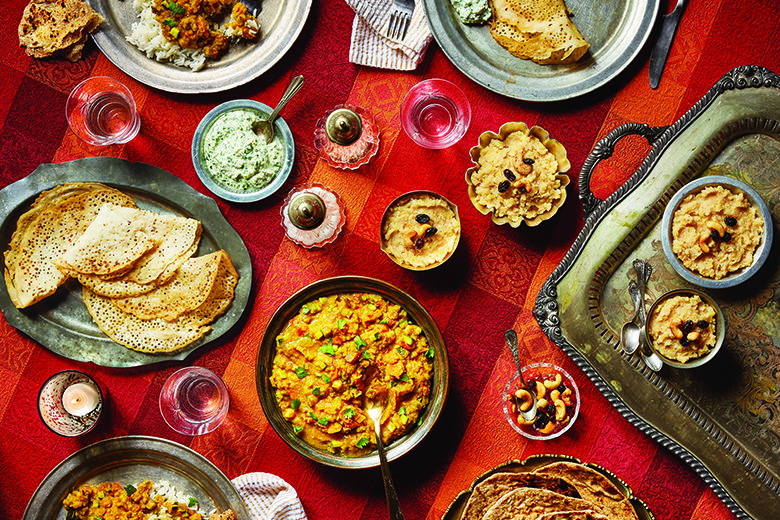
The hissing whistle of steam releasing from the pressure cooker, splattering of mustard or cumin seeds in a kadai (pan), and the aroma of rich spices and herbs — all of these immediately evoke memories of my childhood home in Madras, India (now known as Chennai). Although my family originally was from the northwestern state of Gujarat, we had been living for a few generations in the southern state of Tamil Nadu. Growing up in Madras, my family enjoyed a combination of flavors from both of those states.
My mom (Mummy, as I called her) was a phenomenal cook. She spent long hours in the kitchen creating delicious meals with fresh ingredients and an array of spices. She had a deep interest in cooking and in many ways was revolutionary in terms of being health conscious and adventurous.
My fondest childhood memories include waking up each morning to see my mom heating milk on the stove and making my siblings and me a hot breakfast, as well as fresh, homemade lunches for school. Every morning, the fruit and vegetable vendor stopped by our home and my mom selected produce for the day. She planned all our meals based on what was in season. Talk about having a profound influence on my life and food philosophy!
In Indian culture, food is much more than nourishment; it is synonymous with respect and honor. There is a famous Sanskrit saying, Atithi Devo Bhava: “Guests are like God and need to be treated with the utmost respect and love.” Food is a big part of showing hospitality.
For those unfamiliar with Indian cuisine, it is important to note that food varies vastly in flavors and textures among the various states of India.
Five states — Andhra Pradesh, Karnataka, Kerala, Tamil Nadu and Telangana — form the South of India. They are surrounded by water on three sides and have a hot, humid climate. Rainfall is abundant, leading to plenty of fresh produce and rice, the predominant grain in South Indian cuisine. Andhra Pradesh is known for its spicy cuisine. Hyderabad, the capital city, was the home of the Nizams (Mughals), who ruled for more than 220 years. The royal food is rich and heavily spiced with nuts, dried fruits and saffron. Telangana is known for its heavy use of red chili, tamarind and dals (split lentils). Karnataka is one of the major milk producers of the country. Kerala is known for its wide variety of seafood and coconut-based dishes. It is one of the biggest producers of spices such as peppercorns, cardamom, cinnamon and nutmeg. Some of the dishes in Kerala were influenced by Arabs. Tamil Nadu is known for its predominantly vegetarian cuisine along with fiery spices.
Coconut oil, ghee, gingelly oil, peanut oil and sunflower oil are commonly used for cooking. Common spices and flavorings in South Indian dishes include asafoetida, chilies, fresh coconut, cumin, curry leaves, mustard seeds, pepper, turmeric and tamarind. A variety of dals are used in South Indian cuisine. The traditional South Indian flavor comes from the final tempering, a process of heating a little oil or ghee, frying mustard seeds or cumin seeds, curry leaves, red chilies, asafoetida, fenugreek, urad dal or chana dal, and dried chilies. This mixture is then drizzled over a dish such as sambar (a spicy lentil and vegetable stew), rasam (a broth-like spicy soup) or a vegetable side dish.
Although India is known for chai (tea), there are many coffee plantations in the south, and the South Indian “filter coffee” is a local specialty beverage. Most South Indian homes have a ritual around coffee: Beans are roasted and crushed with chicory. The powder is placed in a stainless-steel filter and hot water is poured through. The decoction (concentrate) is mixed with steamed milk and sugar, poured back and forth from a distance to create frothiness and served in stainless-steel cups.
In general, Indian food is enjoyed with the hands (using only the right hand, as the left hand typically is reserved for personal hygiene needs). South Indian food traditionally is served on a banana leaf or in a stainless steel plate called a thali. The base is rice and there are innumerable varieties of preparation. Rice is enjoyed with sambar, rasam, a variety of vegetable side dishes, chutneys, pickles, yogurt (to soothe the palate after a spicy meal and aid digestion) and payasam (a milk-based dessert) or some other desserts. The meal ends with a small banana, vetelai (betel leaf) and paku (betel nuts), to freshen the mouth and possibly help with digestion.
Other popular dishes often served for breakfast or tiffin (a mini-meal served in the late afternoon or for a light dinner) include those made from a fermented rice and lentil batter idli (steamed cakes), dosai (crepe enjoyed plain or stuffed with a potato-onion mixture called masala) and uthappam (pancakes) typically served with sambar and chutneys.
Fortunately, most key ingredients used to prepare South Indian foods are now easily available in the United States. Light meals such as dosai and chutney continue to be favorites and part of my family’s weekly meal rotation.
I embody the sentiments Atithi Devo Bhava; I love sharing my culture and food traditions with family and friends.
See the South Indian recipes that accompanied this story: Spicy Red Lentil Stew, Rice Dosai with Coconut Chutney and Spiced Rice Pudding.
